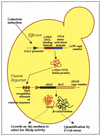A novel yeast system for in vivo selection of recognition sequences: defining an optimal c-Myb-responsive element
- PMID: 11600718
- PMCID: PMC60227
- DOI: 10.1093/nar/29.20.e99
A novel yeast system for in vivo selection of recognition sequences: defining an optimal c-Myb-responsive element
Abstract
Yeast (Saccharomyces cerevisiae) has proved to be a highly valuable tool in a range of screening methods. We present in this work the design and use of a novel yeast effector-reporter system for selection of sequences recognised by DNA-binding proteins in vivo. A dual HIS3-lacZ reporter under the control of a single randomised response element facilitates both positive growth selection of binding sequences and subsequent quantification of the strength of the selected sequence. A galactose-inducible effector allows discrimination between reporter activation caused by the protein under study and activation due to endogenous factors. The system mimics the physiological gene dosage relationship between transcription factor and target genes in vivo by using a low copy effector plasmid and a high copy reporter plasmid, favouring sequence selectivity. The utility of the novel yeast screening system was demonstrated by using it to refine the definition of an optimal recognition element for the c-Myb transcription factor (MRE). We present screening data supporting an extended MRE consensus closely mimicking known strong response elements and where a sequence of 11 nt influences activity. Novel features include a more strict sequence requirement in the second half-site of the MRE where a T-rich sequence is preferred in vivo.
Figures











Similar articles
-
Sequence selectivity of c-Myb in vivo. Resolution of a DNA target specificity paradox.J Biol Chem. 1999 Jul 30;274(31):21986-94. doi: 10.1074/jbc.274.31.21986. J Biol Chem. 1999. PMID: 10419522
-
Two c-myb proteins differing by their aminotermini exhibit different transcriptional transactivation activities (yeast/reporter-effector system).Oncogene. 1991 Jan;6(1):11-9. Oncogene. 1991. PMID: 1992438
-
Flexibility in the second half-site sequence recognised by the c-Myb R2 domain--in vitro and in vivo analysis.Oncogene. 1996 Sep 5;13(5):1043-51. Oncogene. 1996. PMID: 8806694
-
Characterisation of Pt MYB1, an R2R3-MYB from pine xylem.Plant Mol Biol. 2003 Nov;53(4):597-608. doi: 10.1023/B:PLAN.0000019066.07933.d6. Plant Mol Biol. 2003. PMID: 15010621
-
The proximal promoter of the human cathepsin G gene conferring myeloid-specific expression includes C/EBP, c-myb and PU.1 binding sites.Gene. 2005 Aug 15;356:193-202. doi: 10.1016/j.gene.2005.05.004. Gene. 2005. PMID: 16019164
Cited by
-
MYB: A Key Transcription Factor in the Hematopoietic System Subject to Many Levels of Control.Adv Exp Med Biol. 2024;1459:3-29. doi: 10.1007/978-3-031-62731-6_1. Adv Exp Med Biol. 2024. PMID: 39017837 Review.
-
Selective inhibition of c-Myb DNA-binding by RNA polymers.BMC Biochem. 2004 Nov 4;5:15. doi: 10.1186/1471-2091-5-15. BMC Biochem. 2004. PMID: 15527501 Free PMC article.
-
Dissecting the transactivation domain (tAD) of the transcription factor c-Myb to assess recent models of tAD function.FEBS Open Bio. 2020 Nov;10(11):2329-2342. doi: 10.1002/2211-5463.12978. Epub 2020 Sep 25. FEBS Open Bio. 2020. PMID: 32937031 Free PMC article.
-
ALY is a common coactivator of RUNX1 and c-Myb on the type B leukemogenic virus enhancer.J Virol. 2007 Apr;81(7):3503-13. doi: 10.1128/JVI.02253-06. Epub 2007 Jan 17. J Virol. 2007. PMID: 17229714 Free PMC article.
References
-
- Brent R. and Finley,R.L.Jr (1997) Understanding gene and allele function with two-hybrid methods. Annu. Rev. Genet., 31, 663––704.. - PubMed
-
- Fields S. and Song,O. (1989) A novel genetic system to detect protein-protein interactions. Nature, 340, 245––246.. - PubMed
-
- Drees B.L. (1999) Progress and variations in two-hybrid and three-hybrid technologies. Curr. Opin. Chem. Biol., 3, 64––70.. - PubMed
-
- Mendelsohn A.R. and Brent,R. (1999) Protein interaction methods—toward an endgame. Science, 284, 1948––1950.. - PubMed
Publication types
MeSH terms
Substances
LinkOut - more resources
Full Text Sources
Research Materials

